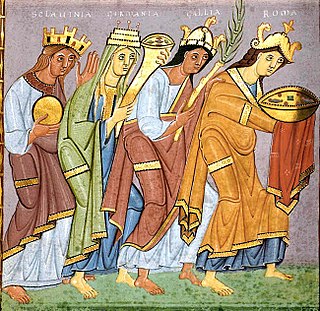
The Curta is a hand-held mechanical calculator designed by Curt Herzstark. It is known for its extremely compact design: a small cylinder that fits in the palm of the hand. It was affectionately known as the "pepper grinder" or "peppermill" due to its shape and means of operation; its superficial resemblance to a certain type of hand grenade also earned it the nickname "math grenade".

Samo founded the first recorded political union of Slavic tribes, known as Samo's Empire, ruling from 623 until his death in 658. According to Fredegarius, the only contemporary source, Samo was a Frankish merchant who unified several Slavic tribes against robber raids and violence by nearby settled Avars, showing such bravery and command skills in battle that he was elected "King of the Slavs". In 631, Samo successfully defended his realm against the Frankish Kingdom in the three-day Battle of Wogastisburg.

The West Slavs are Slavic peoples who speak the West Slavic languages. They separated from the common Slavic group around the 7th century, and established independent polities in Central Europe by the 8th to 9th centuries. The West Slavic languages diversified into their historically attested forms over the 10th to 14th centuries.
The Early Middle Ages in Romania started with the withdrawal of the Roman troops and administration from Dacia province in the 270s. In the next millennium a series of peoples, most of whom only controlled two or three of the nearly ten historical regions that now form Romania, arrived. During this period, society and culture underwent fundamental changes. Town life came to an end in Dacia with the Roman withdrawal, and in Scythia Minor – the other Roman province in the territory of present-day Romania – 400 years later. Fine vessels made on fast potter's wheels disappeared and hand-made pottery became dominant from the 450s. Burial rites changed more than once from cremation to inhumation and vice versa until inhumation became dominant by the end of the 10th century.

True Love is an album by Toots & the Maytals. It is a collection of their classics re-recorded with guest artists including Willie Nelson, Eric Clapton, Jeff Beck, Trey Anastasio, No Doubt, Ben Harper, Bonnie Raitt, Manu Chao, The Roots, Ryan Adams, Keith Richards, and The Skatalites. The album was produced and conceived by Richard Feldman and released on the V2 label.

The Sclaveni or Sklabenoi were early Slavic tribes that raided, invaded and settled in the Balkans in the Early Middle Ages and eventually became one of the progenitors of modern South Slavs. They were mentioned by early Byzantine chroniclers as barbarians having appeared at the Byzantine borders along with the Antes, another Slavic group. The Sclaveni were differentiated from the Antes and Wends ; however, they were described as kin. Eventually, most South Slavic tribes accepted Byzantine or Frankish suzerainty, and came under their cultural influences and Chalcedonian Christianity. The term was widely used as a general catch-all term until the emergence of separate tribal names by the 10th century.
Daniele Cacia is an Italian professional footballer who plays as a striker. He is a former Italy Under 19 international.

Regina Maria Loureiro Barreto CaséOMC is a Brazilian actress, screenwriter, director, producer, and television presenter.

The Antes or Antae were an early Slavic tribal polity of the 6th century CE. They lived on the lower Danube River, in the northwestern Black Sea region, and in the regions around the Don River. Scholars commonly associate the Antes with the archaeological Penkovka culture.
Florin Curta is a Romanian-born American archaeologist and historian who is a professor of medieval history and archaeology at the University of Florida.

Lucas Alberto Simón García is an Argentine naturalized Chilean professional footballer who played as a striker.
Cacia is a civil parish in the municipality of Aveiro. The population in 2011 was 7,354, in an area of 35.75 km².
Zicídeva was an Early Byzantine town, tentatively identified with the late antique settlement excavated on the top of Tsarevets hill, near modern Veliko Tarnovo in northern Bulgaria.

Mesosini is a tribe of longhorn beetles of the subfamily Lamiinae.

Cacia is a genus of longhorn beetles of the subfamily Lamiinae.
Cacia is a civil parish in Aveiro Municipality, Portugal.
Cacia butuana is a species of beetle in the family Cerambycidae. It was described by Heller in 1923.
Cacia semiluctuosa is a species of beetle in the family Cerambycidae. It was described by Émile Blanchard in 1853.

Cacia cretifera is a species of beetle in the family Cerambycidae. It was described by Frederick William Hope in 1831. It is known from Java, Cambodia, India, Myanmar, China, Nepal, Thailand, Laos, and Vietnam. It feeds on Berberis thunbergii and Albizia julibrissin.
The history of Christianity in Hungary started in the Roman province of Pannonia, centuries before the arrival of the Magyars, or Hungarians.










